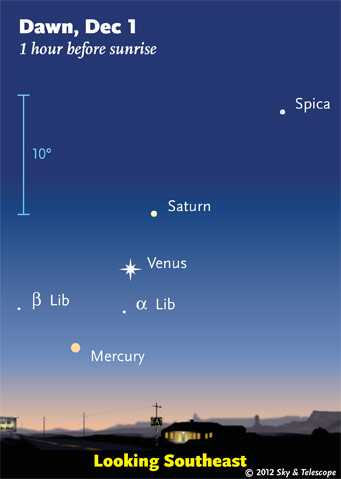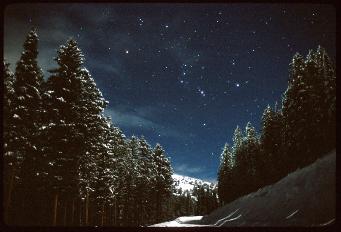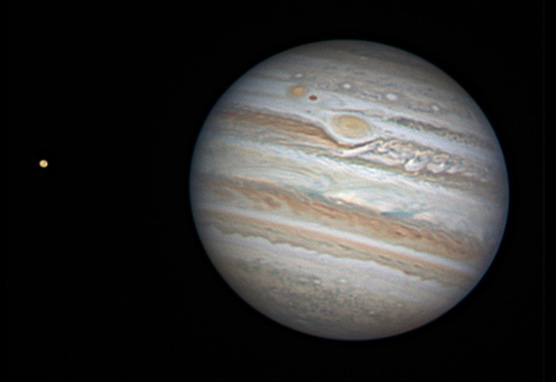
Mercury has emerged into fine view low in early dawn, lining up with Venus and Saturn. Watch all week as the line lenghtens; Saturn (and Spica) move higher to the upper right. The blue 10° scale is about the width of your fist at arm's length.
Sky & Telescope diagram
Friday, November 30
Saturday, December 1
Sunday, December 2

Orion on the rise stands framed between treetops at the start of a cold winter night in Wyoming”™s Teton Mountains. First-quarter moonlight illuminates the scene. Centered between the trees is Orion”™s three-star Belt, nearly vertical. Sirius has not yet risen.
Allan E. Morton
Monday, December 3
Tuesday, December 4
Wednesday, December 5
Thursday, December 6
Friday, December 7
Saturday, December 8
Want to become a better amateur astronomer? Learn your way around the constellations. They're the key to locating everything fainter and deeper to hunt with binoculars or a telescope.
For an easy-to-use constellation guide covering the whole evening sky, use the big monthly map in the center of each issue of Sky & Telescope, the essential guide to astronomy. Or download our free Getting Started in Astronomy booklet (which only has bimonthly maps).
Sky Atlas 2000.0 (the color Deluxe Edition is shown here) plots 81,312 stars to magnitude 8.5. That includes most of the stars that you can see in a good finderscope, and typically one or two stars that will fall within a 50× telescope's field of view wherever you point. About 2,700 deep-sky objects to hunt are plotted among the stars.
Alan MacRobert
Once you get a telescope, to put it to good use you'll need a detailed, large-scale sky atlas (set of charts). The standards are the little Pocket Sky Atlas, which shows stars to magnitude 7.6; the larger and deeper Sky Atlas 2000.0 (stars to magnitude 8.5); and the even larger Uranometria 2000.0 (stars to magnitude 9.75). And read how to use sky charts with a telescope effectively.
You'll also want a good deep-sky guidebook, such as Sue French's Deep-Sky Wonders collection (which includes its own charts), Sky Atlas 2000.0 Companion by Strong and Sinnott, the bigger Night Sky Observer's Guide by Kepple and Sanner, or the beloved if dated Burnham's Celestial Handbook.
Can a computerized telescope replace charts? Not for beginners, I don't think, and certainly not on mounts and tripods that are less than top-quality mechanically (able to point with better than 0.2° repeatability). As Terence Dickinson and Alan Dyer say in their invaluable Backyard Astronomer's Guide, "A full appreciation of the universe cannot come without developing the skills to find things in the sky and understanding how the sky works. This knowledge comes only by spending time under the stars with star maps in hand."
This Week's Planet Roundup
Mercury, Venus, and Saturn form a diagonal line in the southeast when dawn begins to brighten, as shown at the top of this page. Venus is by far the brightest at magnitude –3.9. Look upper right of it for distant Saturn, magnitude +0.7. Look lower left of Venus for Mercury, magnitude –0.5. Mercury is having an excellent apparition through the first half of December. This diagonal line of three lengthens from 13° to 19° long this week.
Added bonus: Look upper right of the planet lineup for Spica, similar to Saturn at magnitude +1.0.
Mars (magnitude +1.2, in Sagittarius) remains low in the southwest in evening twilight. In a telescope it's just a tiny blob 4.4 arcseconds in diameter.

The Great Red Spot's side of Jupiter is busy indeed. Sky & Telescope imaging editor Sean Walker shot this image with his 12.5-inch Newtonian reflector and DMK21AU618 planetary video camera on November 22nd. South is up. From upper left, note the orange ring of Oval BA, the tiny dark-red dot following it, the Great Red Spot in its white Red Spot Hollow, and the huge turbulence behind it roiling the South Equatorial Belt.
The South Temperate Belt is barely visible along some of its length but prominent on the following side of the Great Red Spot. Four white ovals dot the South South Temperate Belt. On the north side of the planet, the North Equatorial and North Temperate belts have become cleanly separated by the North Tropical Zone's return to whiteness. Blue festoons intrude into the bright Equatorial Zone. The satellite to the left is sulfur-colored Io.
S&T: Sean Walker
.
Jupiter (magnitude –2.8, in Taurus) is at opposition this week (opposite the Sun as seen from Earth). It rises around sunset, climbs the eastern sky in the evening, shines highest in the south around midnight, and sets in the west around sunrise. Orange Aldebaran is 5° to its lower right during evening. Above them are the Pleiades. In a telescope, Jupiter is big 48 arcseconds wide, essentially as large as ever appears.
Uranus (magnitude 5.8, in Pisces) and Neptune (7.9, in Aquarius) are conveniently placed in the south right after dark. Finder charts for Uranus and Neptune.
All descriptions that relate to your horizon — including the words up, down, right, and left — are written for the world's mid-northern latitudes. Descriptions that also depend on longitude (mainly Moon positions) are for North America. Eastern Standard Time (EST) equals Universal Time (also known as UT, UTC, or GMT) minus 5 hours.
Like This Week's Sky at a Glance? Watch our SkyWeek TV short. It's also playing on PBS!
To be sure to get the current Sky at a Glance, bookmark this URL:
http://SkyandTelescope.com/observing/ataglance?1=1
If pictures fail to load, refresh the page. If they still fail to load, change the 1 at the end of the URL to any other character and try again.
 0
0
Comments
You must be logged in to post a comment.